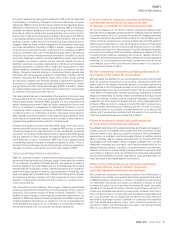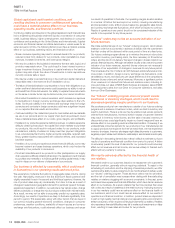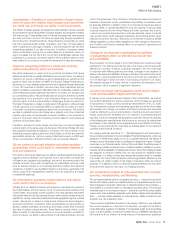Nike 2011 Annual Report Download - page 19
Download and view the complete annual report
Please find page 19 of the 2011 Nike annual report below. You can navigate through the pages in the report by either clicking on the pages listed below, or by using the keyword search tool below to find specific information within the annual report.
19NIKE,INC.-Form10-K
PARTII
ITEM7Management’s Discussion and Analysis of Financial Condition and Results of Operations
The reported futures and advance orders growth is not necessarily indicative
of our expectation of revenue growth during this period. This is due toyear-
over-year changes in shipment timing and because the mix of orders can shift
between advance/futures and at-once orders and the fulfi llment of certain
orders may fall outside of the schedule noted above. In addition, exchange
rate fl uctuations as well as differing levels of order cancellations and discounts
can cause differences in the comparisons between advance/futures orders and
actual revenues. Moreover, a signifi cant portion of our revenue is not derived
from futures and advance orders, including at-once and close-out sales of
NIKE Brand footwear and apparel, sales of NIKE Brand equipment, sales from
our Direct to Consumer operations, and sales from our Other Businesses.
Gross Margin
(Inmillions)
Fiscal2011 Fiscal2010
FY11vs. FY10
%Change Fiscal2009
FY10vs. FY09
%Change
Gross Margin $ 9,508 $ 8,800 8 % $ 8,604 2 %
Gross Margin % 45.6 % 46.3 % (70 )bps 44.9 % 140 bps
Fiscal 2011 Compared to Fiscal 2010
For fi scal2011, our consolidated gross margin percentage was 70 basis
points lower than the prioryear. The primary factors contributing to this
decrease were as follows:
• Higher input costs across most businesses,
•
Increased transportation costs, including additional air freight incurred to
meet strong demand for NIKE Brand products across most businesses,
most notably in North America, Western Europe, and Central& Eastern
Europe geographies, and
•
A lower mix of licensee revenue as distribution for certain markets within our
Other Businesses transitioned from licensees to operating units of NIKE,Inc.
Together, these factors decreased consolidated gross margins by approximately
130 basis points for fi scal2011, with the most signifi cant erosion in the second
half of the fi scalyear. These decreases were partially offset by the positive
impact from the growth and expanding profi tability of our NIKE Brand Direct
to Consumer business, a higher mix of full-price sales and favorable impacts
from our ongoing product cost effi ciency initiatives.
As we head into fi scal2012, we anticipate that our gross margins will continue
to face pressure from macroeconomic factors, most notably rising product
input costs as well as higher transportation costs, which may more than
offset the favorable impact from our planned price increases and ongoing
production cost effi ciency initiatives.
Fiscal 2010 Compared to Fiscal 2009
For fi scal2010, our consolidated gross margin percentage was 140 basis
points higher than the prioryear. The primary factors contributing to this
improvement were as follows:
•
Improved in-line product margins across most geographies, driven by reduced
raw material and freight costs as well as favorable changes in product mix,
• Improved inventory positions, most notably in North America and Western
Europe, which drove a shift in mix from discounted close-out to higher
margin in-line sales, and
•
Growth of NIKE-owned retail as a percentage of total revenue, across most
NIKE Brand geographies, driven by an increase in both new store openings
and comparable store sales.
Together, these factors increased consolidated gross margins by approximately
160basis points for fi scal2010. These increases were partially offset by the
impact of unfavorable currency exchange rates, primarily affecting our Emerging
Markets and Central& Eastern Europe geographies.
Selling and Administrative Expense
(Inmillions)
Fiscal2011 Fiscal2010
FY11vs. FY10
% Change Fiscal2009
FY10vs. FY09
%Change
Demand creation expense
(1) $ 2,448 $ 2,356 4 % $ 2,352 0 %
Operating overhead expense 4,245 3,970 7 % 3,798 5 %
Selling and administrative expense $ 6,693 $ 6,326 6 % $ 6,150 3 %
% of Revenues 32.1 % 33.3 % (120 )bps 32.1 % 120 bps
(1) Demand creation consists of advertising and promotion expenses, including costs of endorsement contracts.
Fiscal 2011 Compared to Fiscal 2010
In fi scal2011, the effect of changes in foreign currency exchange rates did
not have a signifi cant impact on selling and administrative expense.
Demand creation expense increased 4% compared to the prioryear, primarily
driven by a higher level of brand event spending around the World Cup and
World Basketball Festival in the fi rst half of fi scal2011, as well as increased
spending around key product initiatives and investments in retail product
presentation with wholesale customers.
Operating overhead expense increased 7% compared to the prioryear.
Thisincrease was primarily attributable to increased investments in our Direct
to Consumer operations as well as growth in our wholesale operations, where
we incurred higher personnel costs and travel expenses as compared to the
prioryear.
Fiscal 2010 Compared to Fiscal 2009
In fi scal2010, changes in currency exchange rates had a minimal impact on
demand creation expense. Demand creation expense remained fl at compared
to the prioryear, as increases in sports marketing and digital marketing
expenses were offset by reductions in advertising.
Excluding changes in exchange rates, operating overhead expense increased
4% compared to the prioryear due primarily to increases in performance-
based compensation and investments in our Direct to Consumer operations.
These increases were partially offset by reductions in compensation spending
in fi scal2010 as a result of restructuring activities that took place in the fourth
quarter of fi scal2009.
























